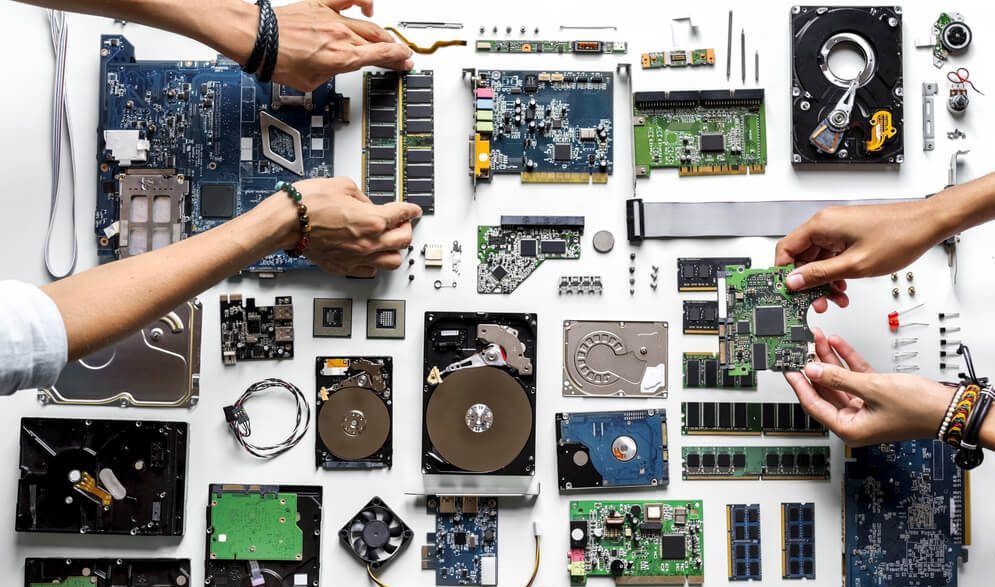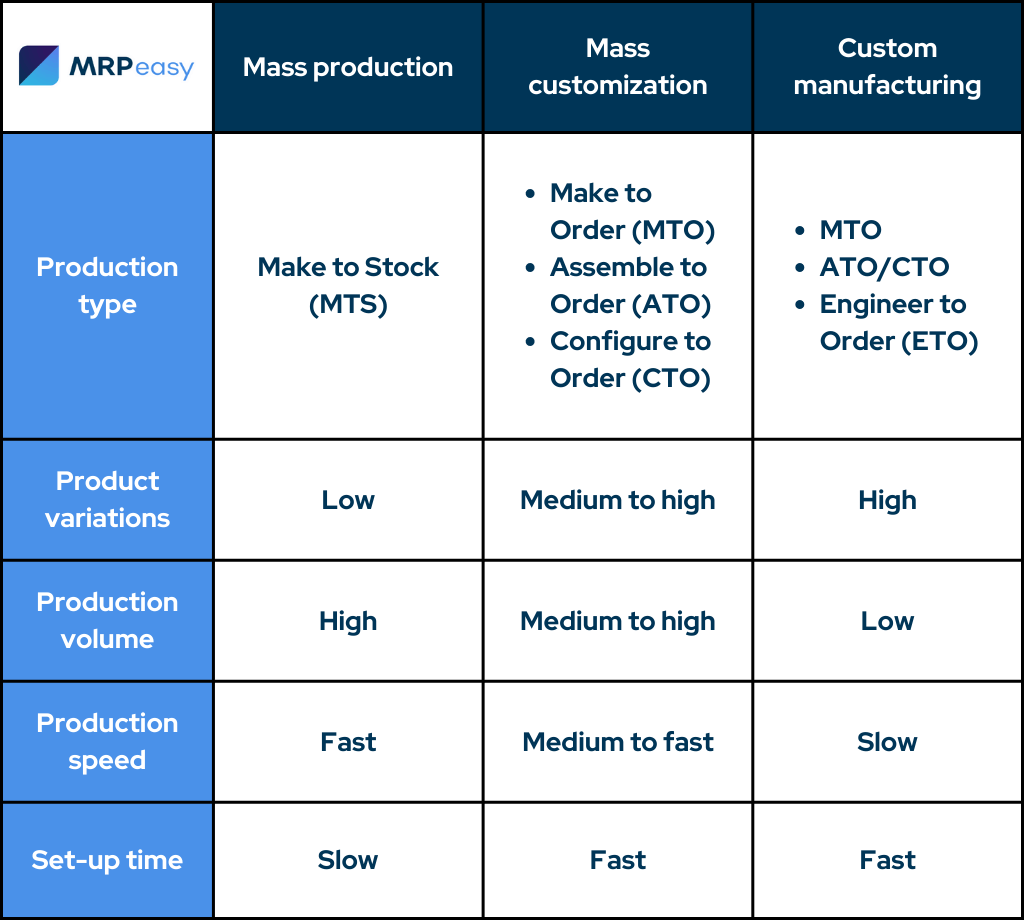Mass Customization – A Viable Option for Small Manufacturers
Mass customization is a mixed manufacturing mode with characteristics from both mass production and make-to-order production modes. Modern software solutions such as product configurators make mass customization available even to small manufacturers.

You can also listen to this article:
What is mass customization?
Mass customization is a mixed manufacturing mode that consists of mass-producing goods and concurrently modifying them according to customers’ requirements. Mass customization can also refer to assemble-to-order (ATO) or configure-to-order ( CTO) manufacturing processes where readily available components are used to build iterations of a product according to the customer’s specifications.
Utilizing mass customization in a manufacturing business can help lower the cost per unit compared to producing conventionally tailor-made products, while still providing a degree of customization. The options offered by mass customization companies can range from small tweaks to the color, size, material, etc., of a product, to configuring entire products from available components.
Joseph Pine, the author of the groundbreaking book “Mass Customization: The New Frontier in Business Competition”, used the concept of mass customization to address the issue of companies becoming overly customer-centric, i.e. trying to fulfill every customer’s needs. With the ever-increasing diversity of customers and their needs, this highly customer-oriented approach would prove to be a pitfall of increased costs and complexity. Mass customization is a production methodology to address this shift.
Mass customization has become a viable approach for small manufacturers due to the onset of new marketing technologies, 3D printing and more effortless prototyping, product configurators, and advanced manufacturing ERP software.
Mass customization vs. mass production vs. make-to-order?
Mass customization lies fluidly in between mass production and the make-to-order production workflows. In traditional mass production, large-scale manufacturing or assembly lines are configured once initially and then set in motion to output mostly high volumes of identical goods. Reconfiguring the line to produce new products generally requires resetting large parts of the production line. In the make-to-order production process, however, production lines are usually shorter and set up according to the custom requirements of usually much smaller incoming orders.
Mass customization provides a middle ground between the two. Here, production lines are still designed to output higher volumes of products. However, built-in modularity and specific process steps in the production line enable customizing parts of the product. This increases the diversity of the output. Here is an easy-to-grasp comparison between the three:

Read more about Make-to-Order and Assemble-to-Order Process Flow and Best Practices.
The four types of mass customization
Pine (1992) distinguishes four primary types of mass customization: collaborative, adaptive, transparent, and cosmetic. Let’s go over these customization approaches in a bit more detail.ive, adaptive, transparent, and cosmetic.
Collaborative customization
This mode of mass customization is based on interaction with the customers. Clients are enabled to detail their requirements and customer preferences. These inputs are then used to customize the individual products accordingly. For example, a company could have a product configurator running on their website which the customers can use to configure a product to their specific needs. Collaborative customization is distinct from make-to-order in that certain aspects of a product are able to be customized without changing the base product.
Collaborative customization is the most popular and widely-used type of mass customization. A relevant example would be the tech giants Lenovo and Dell who allow a degree of customization for their laptops and workstations on-site.
Adaptive customization
This customization process involves producing a standard product that allows end users to modify it themselves. Adaptive customization relies on intricate product optimization, e.g., being designed in a way to be customizable from the get-go.
Examples include programmable electronic devices such as LED lights and the world-famous mini-computer Raspberry Pi, but also blank canvas clothing items, customizable bicycles and skateboards, adaptive cosmetics, etc.
Cosmetic customization
In cosmetic customization, identical products are given different external presentations, such as decals or packages. Customizing the exterior part of the same product can be useful for increasing traction in different markets, locations, retailer preferences, or even for different individuals. Cosmetic customization, therefore, usually occurs in the post-processing or packaging phase of manufacturing.
A good example of cosmetic customization would be the Coca-Cola marketing campaign “Share a Coke”. During the campaign, Coke included popular forenames on the bottle’s labels, localized to the region they were sold at, to create a personal relationship with shoppers.
Transparent customization
Transparent customization is a customization strategy in which manufacturers produce customized goods for specific customers without expressly communicating it to the customers. Data acquisition tools are leveraged to gain insights into the perceived preferences of different customers or their segments. The customized goods are then manufactured and offered up in marketing campaigns to targeted segments.
Transparent customization is still relatively new but has gained huge traction in recent years with the advent of internet cookies and digital data collection. Most readers will have seen advertisements on the internet that promote a t-shirt or a mug with an image they recently searched for on Google, for example.
Mass Customization with a product configurator
Implementing a product configurator is one of the most cost-effective ways to include customers in the value-creation process while still retaining the short lead times characteristic of mass production. This type of software allows for individual offerings and a shopping experience that may lead to greater customer loyalty. On the production side, they also reduce overproduction and errors in the ordering process.
Product configurators can be operated by sales employees that get input from the customers and configure the bill of materials (BOM) of the product based on that input. Or by the customer via software solutions, a company web page, or an eCommerce site.

Product configurators may work on various principles. The easiest-to-use product configurator is the Matrix BOM functionality which allows parts of a product’s bill of materials to be modified by choosing different parameter values. The final BOM is then put together according to the configuration. This is how the product configurator of MRPeasy operates.
Thanks to integrating with various e-commerce platforms such as Shopify or WooCommerce, MRPeasy’s product configurator makes it easy to include the customer in the value-creation process by offering customization options that you’ve made previously available on your product lineup.
Benefits of using a product configurator
Using a product configurator can have many benefits for a business. Here are a few:
- Reduce lead times
By offering clear-cut features and parameters for the customer to choose from, the product configurator is able to quickly produce a BOM where all the parts fit. This eliminates the need for a salesperson or product designer to process the customer input to determine the most viable specification. The result is a notable reduction in lead times, greater speed and accuracy in quotations, and increased customer satisfaction. - Reduce errors
With the customer deciding on the parameters of the product and the BOM software converting the sales order to a manufacturing order, there will be less chance for communication errors that could affect the outcomes. - Keep BOMs organized
Having BOMs with parameters will drastically tidy up documentation related to different builds. Instead of hundreds of separate BOMs, bills of materials can be organized into BOM families with different variants. - Create new standard products
Collecting data about the specifications of the custom products that customers have ordered allows for identifying more popular combinations. These can then be turned into standard offerings which translate into a competitive advantage. - Retain customers
Offering unique products with value added by the customers themselves is a surefire way to create a memorable purchasing experience. Add to that short lead times and good prices and you will have a recipe for great customer retention.
Key takeaways
- Mass customization is a mixed mode of manufacturing consisting of characteristics from both mass production and make-to-order production modes.
- Employing mass customization can ensure a low cost per unit compared to traditionally tailor-made products while still providing a fair amount of customization options.
- Today, mass customization has become a viable approach for small manufacturers thanks to different software solutions and 3D printing.
- There are four different types of mass customization: collaborative, adaptive, transparent, and cosmetic.
- Using a product configurator is a great way to have the customer collaborate in the product design process.
- Product configurators rely on set options or rules to create the BOM of a customized product.
- Implementing a product configurator can help a mass customization company reduce lead times, improve quote accuracy, reduce communication errors, organize BOMs, create new standard products, and create customer loyalty.
Frequently asked questions
In mass customization, production lines are set up in a way that allows for relatively large production volumes while retaining a viable level of customization in the end products. For example, the personal computer manufacturers Dell and Lenovo both offer configurable products for many of their laptops and workstations – the base model remains the same, however, many aspects of the computers’ specifications (like RAM, processor, screen, etc.) can be chosen by the customer online.
The four methods of mass customization are:
1. Collaborative customization wherein customers actively participate in product design, customizing features to suit their preferences.
2. Adaptive customization, wherein standardized products are designed to be user-customizable.
3. Cosmetic customization in which standard products are cosmetically customized chiefly for marketing purposes.
4. Transparent customization, in which products are customized according to information obtained using online marketing tools to cater to specific users or user segments without the customers’ active participation.
In manufacturing, mass customization brings together the scale effects and large production volumes of mass production with the customizability of production processes like make-to-order and assemble-to-order. This enables a degree of customization while keeping lead times short and product cost low.
You may also like: How to Manage Product Variants in Manufacturing?




